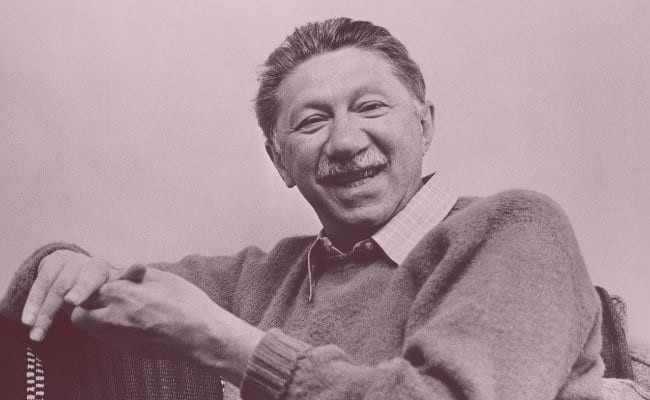Maslow’s Pyramid is part of a psychological theory that inquires about motivation and the needs of the human being: what leads us to act as we do. According to Abraham Maslow, a humanistic psychologist, our actions are born from motivation directed towards the objective of meeting certain needs, which can be ordered according to the importance they have for our well-being.
That is, Maslow proposed a theory according to which there is a hierarchy of human needs, and argued that as the most basic needs are satisfied, human beings develop higher needs and desires. From this hierarchy, what is known as Maslow’s pyramid.
Abraham Maslow first introduced the concept of hierarchy of needs in his article “A Theory of Human Motivation” in 1943 and in his book “Motivation and Personality”. Later, the fact that this hierarchy was usually represented graphically pyramid shaped made the core of the theory become known as Maslow’s pyramidwhose popularity is notable even today, decades after it was first proposed.
Maslow’s Pyramid: what is it?

While some schools existing in the mid-20th century (psychoanalysis or behaviorism) focused on problematic behaviors and learning from a passive being and without many options to influence the environment more than it influences him, Maslow was more concerned with learning about what makes people happier and what can be done to improve personal development and self-actualization.
As a humanist, his idea was that people have an innate desire to self-actualize, to be whatever they want to be, and that they have the capacity to pursue their goals autonomously if they are in a conducive environment. However, the different objectives that are pursued at each moment depend on which goal has been achieved and which ones remain to be met, according to the pyramid of needs. To aspire to the goals of self-realization, previous needs such as food, security, etc. must first be met. For example, we only worry about issues related to self-actualization if we are sure that we have a stable job, guaranteed food, and friends who accept us.
In Maslow’s Pyramid, from the most basic needs to the most complex needs, this hierarchy is made up of five levels. Basic needs are located at the base of the pyramid, while more complex needs are found at the top.
Thus, the five categories of needs in Maslow’s Pyramid are: physiological, security, affiliation, recognition and self-realization ; physiological needs being the lowest level, and rising levels in the indicated order. Of course, as we have seen, the visual representation in the form of a pyramid is a subsequent contribution to Maslow’s approach to this explanatory model. However, here we will treat it as if it were equivalent to the hierarchy of needs described by this psychologist.
Types of needs
In Maslow’s pyramid, this researcher talks about the instinctive needs and makes a distinction between “deficit” needs (physiological, security, affiliation, recognition) and “development of the being” (self-realization). The difference between one and the other is due to the fact that “deficits” refer to a lack, while those of “development of the being” refer to the individual’s work. Satisfying deficit needs is important to avoid unpleasant consequences or feelings.
The needs of the “development of the being”, for their part, are important for personal growth, and do not have to do with the deficit of something, but with the desire to grow as a person.
Thus, Maslow’s pyramid has 5 levels of needs They are the following.
1. Physiological needs
They include the vital needs for survival and they are of a biological order. Within this group, we find needs such as: the need to breathe, to drink water, to sleep, to eat, for sex, for shelter.
Thus, in this stratum of needs are those that make possible the most fundamental biological processes that make the existence of the body viable. They provide coverage for the physiological functions that maintain balance in our tissues, cells, organs and, especially, our nervous system.
Maslow thinks that these needs are the most basic in the hierarchy, since other needs are secondary until those at this level have been met.
2. Security needs
This part of Maslow’s pyramid includes security needs that are necessary to live, but they are at a different level than physiological needs. That is, until the first ones are satisfied, a second link of needs does not arise that are oriented towards personal security to order, stability and protection.
It can be said that the needs that belong to this level of Maslow’s pyramid have to do with expectations and with the way in which living conditions allow the development of medium and long-term projects. They are based on a kind of “cushion” based on both assets and rights and social capital.
These include: physical security, employment security, income and resource security, family security, health security, etc.
3. Membership needs
Maslow describes these needs as less basic, and they make sense when the previous needs are satisfied.
For Maslow, this need is expressed when people seek to overcome feelings of loneliness and feel that there are emotional ties between them and certain people. That is, when an attempt is made to transcend the individual sphere and establish links with the social environment.
These needs continually arise in daily life, when human beings show desires to get married, have a family, be part of a community, be a member of a church or attend a social club. Belonging to a group, whether more or less small, helps to provide meaning to what is done on a daily basis, and also the personal contact and social relationships that these ties encourage stimulate us in a way that, for Maslow, , the resulting experience can be described as necessity.
Examples of these needs are reciprocated love, affection, and belonging or affiliation to a certain social group.
4. Recognition needs
This level of the hierarchy of human needs is also known as esteem needs, and has to do with the way in which we value ourselves and others, the rest of society, value us.
After covering the needs of the first three levels of Maslow’s Pyramid, recognition needs appear as those that favor the strengthening of self-esteem, recognition of one’s own person, particular achievement and respect for others; By satisfying these needs, the person feels self-confident and thinks that it is valuable within society When these needs are not met, people feel inferior and worthless.
This need for Maslow’s hierarchy is best understood as a way of feeling good about our own self-concept through those things about ourselves that we see reflected in the way others treat us.
According to Maslow, there are two recognition needs: a lower one, which includes the respect of others, the need for status, fame, glory, recognition, attention, reputation, and dignity; and a higher one, which determines the need for self-respect, including feelings such as self-confidence, competence, achievement, independence and freedom.
Thus, this level of the hierarchy of human needs is based on all those advantages that come with enjoying a good status in the eyes of others.
5. Self-actualization needs
Finally, at the highest level are the needs for self-actualization and the development of internal needs spiritual and moral development, the search for a mission in life, selfless help towards others, etc.
This level of Maslow’s pyramid is one of the most difficult ranges of the hierarchy of needs to define, because it has to do with highly abstract objectives that are not achieved with concrete actions, but with chains of actions that occur over relatively long periods. long. Consequently, each individual will have different and personalized self-actualization needs.
Criticisms of Maslow’s Pyramid
Although some research supports Abraham Maslow’s theory, most of the data collected in many investigations they don’t seem to go along the same line than Maslow’s pyramid. For example, Wahba and Bridwell (1986) conclude that there is little evidence to demonstrate the hierarchy postulated by Maslow, even though it is still very popular today.
Besides, Maslow’s Pyramid has also received criticism for being difficult to prove his concept of self-actualization, since it is very abstract. Ultimately, in science it is necessary to specify very well the meaning of words and propose “operational” implications of them, and if a concept leaves a lot of room for interpretation, it is not possible to carry out research aimed at studying the same thing, nor draw clear conclusions. Many of the concepts and categories described in Maslow’s pyramid of needs are too ambiguous to be studied scientifically.
In a study published in 2011, researchers at the University of Illinois put Maslow’s pyramid to the test and found that satisfying the pyramid’s needs correlated with a person’s happiness. But this research, unlike Maslow’s theory, concluded that the needs for recognition and self-realization were also important even though the most basic needs were not covered. Therefore, he questioned the sequentiality that Maslow proposed in his theory: it was not necessary to have basic needs met to aspire to achieve the objectives related to the more refined needs.
On the other hand, Maslow’s research was based on a very small and, therefore, unrepresentative sample of individuals. The criticism of his methodology refers to the fact that he himself chose the people he considered self-realized, after reading about them or talking to them and reaching conclusions about what self-realization is. In fact, the people Maslow interviewed when creating his pyramid of needs can hardly represent the majority of the human population, since they were people belonging to Western culture, rich or very influential. Some of the people he investigated are Albert Einstein or Eleanor Roosevelt Maslow’s pyramid was created from the study of exceptional cases, rather than what is normal in human populations.
The relevance and legacy of this theory
Regardless of these criticisms, Maslow’s pyramid represents an important contribution in a change of vision within psychology and helped establish a third force within the profession (the other two main forces were psychoanalysis and behaviorism). His approach to psychology and life in general inspires enthusiasm, no longer assuming that people are passive beings, nor does he focus on pathological behaviors. The study of motivations and behavioral patterns not linked to mental disorders became an example that psychology does not have to be limited to mental health.
On the other hand, Maslow’s works were a first attempt to study something of utmost importance: the common good, those contextual elements that are priorities for all people. If the need to have access to food is one of the most important aspects for people, it is possible to propose space management models that take this principle into account.
Furthermore, Maslow’s pyramid has had a great impact not only in psychology, but it has also been important in the business world (especially in marketing, but also in the world of Human Resources) or in sports, for example. . The fact that it establishes a hierarchy of needs provides an easy and intuitive way to establish plans to motivate and to generate attractive products depending on the type of people you intend to influence.
Current scientific psychology must continue investigating what motivates us and leads us to aspire to goals, and Maslow’s pyramid may not be a construct that can explain well how we act, but at least it is a first brick in this type of studies and can be used as a reference. Of course, we need to continue working to generate concrete concepts that lend themselves to scientific research, beyond appealing to vague ideas that can mean different things for each individual.









